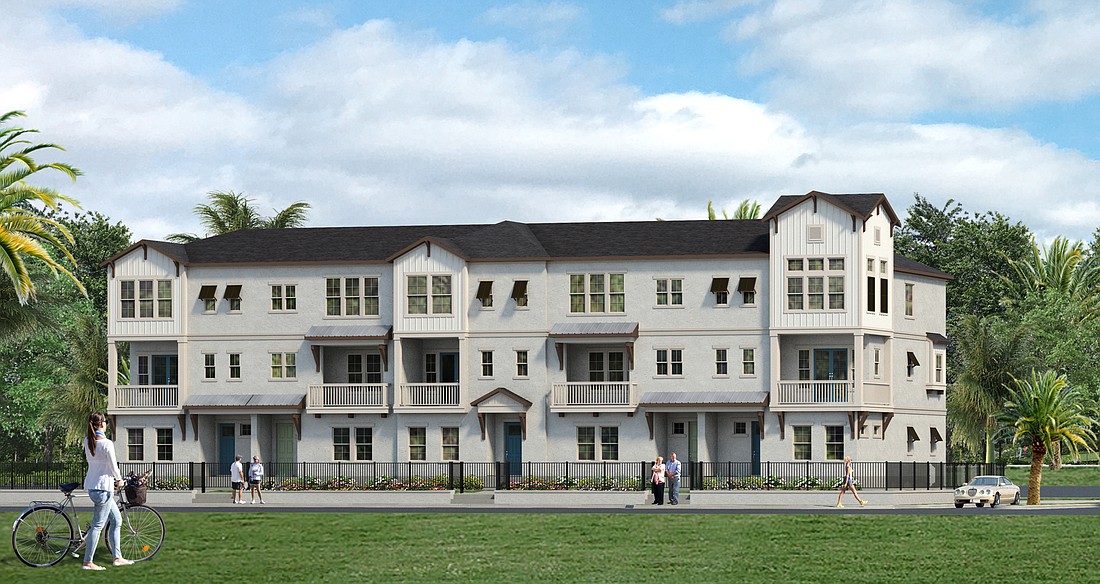- April 4, 2025
-
-
Loading

Thirteen years after a developer originally proposed a residential complex on a School Avenue property across from Payne Park, construction is finally set to begin at the site later this summer.
The Payne Park Village project has been significantly scaled down from the first concepts, which called for 450 condominiums in buildings up to seven stories. Now under the ownership of a new company, David Weekley Homes, the plans for the 8.7-acre parcel include 135 attached and detached single-family homes between three and four stories.
Although the scope of the project may be reduced, the developer believes Payne Park Village can help reshape the segment of the city east of downtown.
Jimmy Oriol, the Sarasota division president for David Weekley Homes, said the company was excited to break ground in an area that has not yet been a hub for the same kind of growth taking place in other districts bordering the city’s center.
“We feel like it’s the next evolution, and we’re happy to be a part of the revitalization of that area,” Oriol said.
There may be reason to be bullish about the future of the area east of U.S. 301. Just northeast of the Payne Park Village site, another long-awaited project is prepared to begin construction soon. At the former home of the Ringling Shopping Center, the subject of the city’s contentious decisions to reject plans for a Walmart supercenter, a developer is set to start work on a 222-unit apartment complex.
Though the completion of both projects is still more than a year away, the prospect of adding more than 350 residential units could reshape the dynamics of the area.
Patrick Berman, a retail specialist with Cushman & Wakefield, is marketing the commercial parcels on the Ringling Shopping Center property at 2260 Ringling Blvd. He anticipates the introduction of more full-time residents into the area will have a noticeable effect.
“Once you start seeing some of these projects coming out of the ground and being occupied, the positive impact to those neighborhoods is immediate and demonstrative,” Berman said.
Even before these large projects begin construction, there have been signs of increased interest immediately east of downtown.
Tampa-based developer Icon Residential is constructing a 37-unit town home project at 41 N. School Ave., along the road’s intersection with Main Street. The company plans to follow that up with another 32 town homes on First Street between East Avenue and Audubon Place.
Two hotels are planned east of U.S. 301 between Fruitville Road and Ringling Boulevard. So is a 7,000-square-foot retail complex at 218 N. East Ave. It remains to be seen how many of these projects come to fruition, but Berman said it made sense for developers to seek a new frontier given the rate of activity downtown and in the Rosemary District.
“It’s a matter of supply and demand, where finding vacant zone-entitled lots are hard to come by,” Berman said. “Once the apartments begin construction, we’ll get an even better response.”
Oriol highlighted another potential project that could increase interest in the area — the possible extension of the Legacy Trail to Payne Park. In November, county voters will vote on a bond issue for the project. If it passes, Oriol anticipated the trail would be a meaningful catalyst for additional activity.
“Once you start seeing some of these projects coming out of the ground and being occupied, the positive impact to those neighborhoods is immediate and demonstrative.” — Patrick Berman
That’s not to say an imminent building boom in the area is guaranteed. John Harshman, head of commercial real estate brokerage firm Harshman & Co., has recently found contract purchasers for two properties east of downtown. He, too, is optimistic about the future of this section of the city, but he said there are some specific challenges associated with the area.
The county jail, located at 2020 Main St., is a potential turn-off for development. The courthouse and law enforcement facilities in the area are a hub for activity, but the activity is generally limited to business hours, which means there’s a lack of foot traffic during the evenings and on the weekends. Harshman pointed out there’s not the same amount of retail activity as there is in the redeveloping Rosemary District — not as many restaurants, shops or gyms.
“You don’t have those yet east of 301,” Harshman said. “We’re hoping to see more of that go in there as there are more residents that make the demand.”
But Harshman said there are some benefits of presenting a relatively blank canvas to developers. He said there’s not one type of person interested in investing in the area. Instead, it’s attracting a mix of builders.
Closer to U.S. 301, one might be interested in capitalizing on the proximity to downtown. Near Lime Avenue, another might be interested in creating a more residential setting and marketing the access to not only downtown, but also Fruitville Road as a link to Interstate 75. Whether developers are focused on residential products, hotels or retail space, the area has some appeal to those interested in getting an early foothold in an up-and-coming sector.
“They’re all seeing something in this area that they like,” Harshman said. “They’re used to seeing areas where there’s a little bit of pioneering going on.”